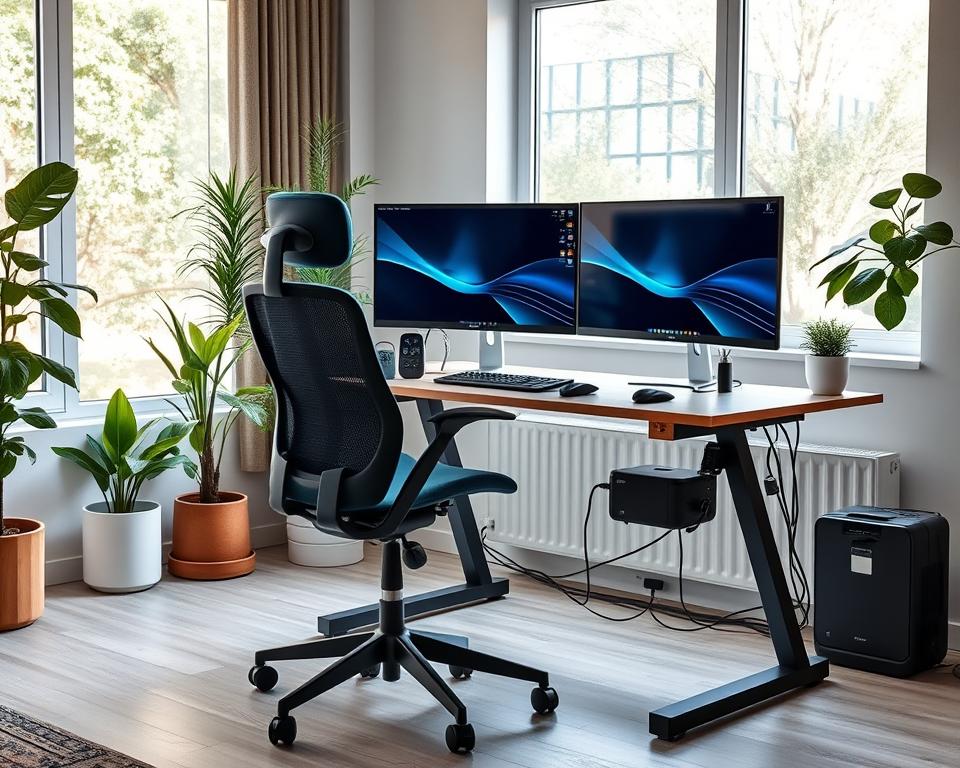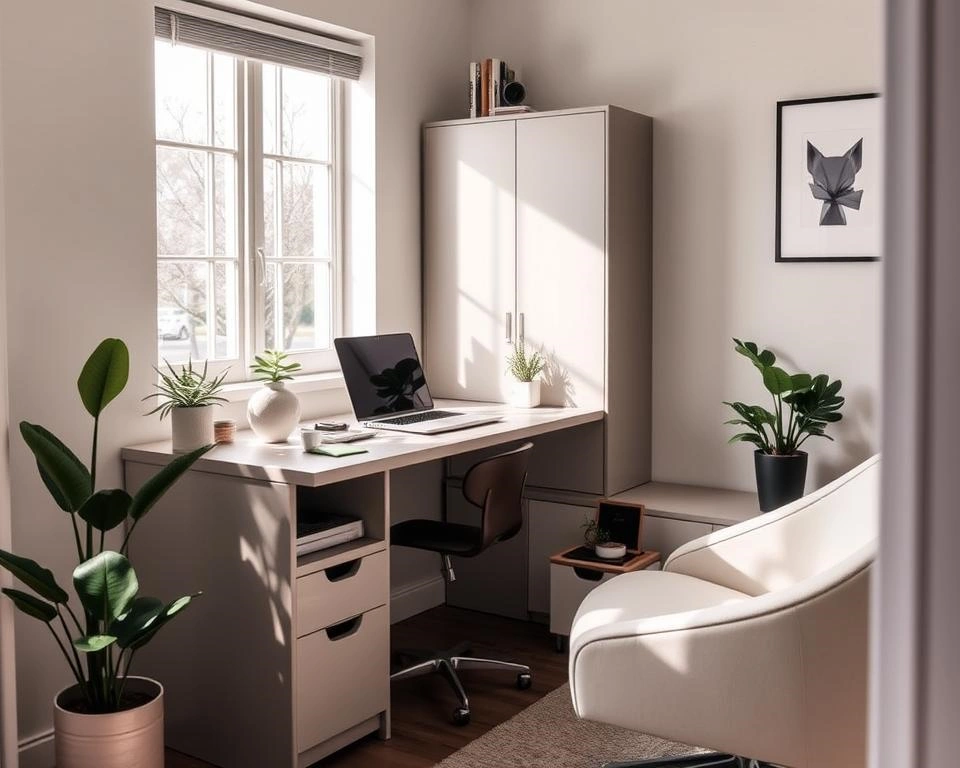Did you know over 80% of American workers now work from home? With more people working from home, having an ergonomic home office setup is more important than ever. This guide will help you make your workspace better, leading to more productivity, less discomfort, and better health.
Ergonomics is all about designing spaces and tools for better health and work. It helps prevent health problems like back pain and eye strain from too much desk work. In this article, you’ll find tips and advice to make your home office more comfortable and productive.
Understanding Home Office Ergonomics Fundamentals
Creating an ergonomic workspace is key for comfort, productivity, and health at home. The main ideas of workplace ergonomics work well in home offices. This ensures your home office ergonomics are set up for the best results.
Key Principles of Workplace Ergonomics
Workplace ergonomics aims to design work areas and tools to meet the user’s needs. Key points include:
- Proper posture and body alignment
- Minimizing repetitive movements and strain
- Adjustable and customizable workstation components
- Adequate support for the back, neck, and limbs
Health Benefits of Proper Ergonomics
Using ergonomic workspace ideas in your home office greatly improves health. Good ergonomics can help:
- Lower the risk of musculoskeletal disorders like back pain and carpal tunnel syndrome
- Boost circulation and blood flow, ensuring muscles get enough oxygen
- Improve posture and reduce fatigue, leading to more productivity and focus
- Lessen eye strain and headaches from too much screen time
Common Ergonomic Mistakes to Avoid
When setting up your home office ergonomics, watch out for common mistakes. These can undo the benefits of a well-designed space. Mistakes include:
- Improper chair height or lack of lumbar support
- Keyboard and mouse placement that leads to wrist strain
- Glare or improper lighting that can cause eye fatigue
- Cluttered or disorganized workstation that hinders productivity
Knowing the basics of workplace ergonomics and avoiding these mistakes helps. You can make a ergonomic workspace that supports your health, comfort, and productivity at home.
Essential Components of an Ergonomic Home Office Setup
Setting up an ergonomic home office is key for staying comfortable and productive. It also helps keep you healthy in the long run. The main parts of a good workspace include:
- Adjustable Desk: An adjustable desk lets you switch between sitting and standing. This helps keep your posture right and prevents problems from sitting too much.
- Supportive Chair: A good ergonomic chair has lumbar support and can be adjusted. It helps ease back pain and keeps your spine aligned.
- Proper Lighting: Your home office needs the right light to avoid eye strain and headaches. Make sure it’s bright but without glare.
- Organizational Accessories: Having the right storage and tools keeps your space tidy. This helps you stay focused and work better.
Choosing the right ergonomic home office setup parts makes a big difference. It helps you stay healthy and do your best work from home.
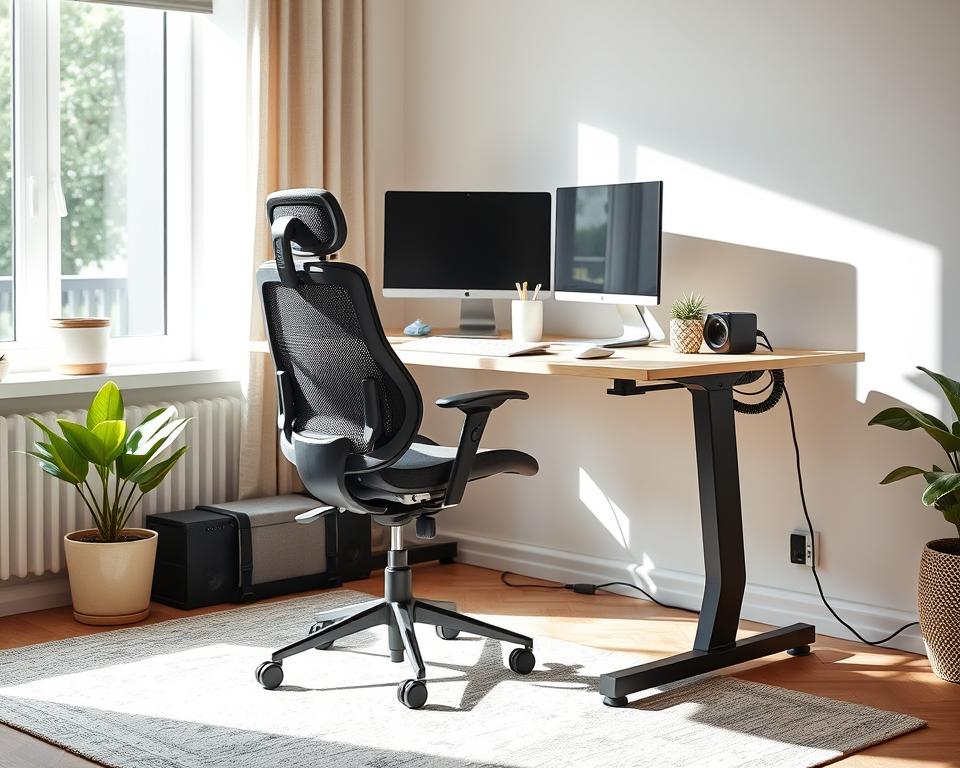
“An ergonomic workspace not only boosts productivity but also helps prevent long-term health issues associated with poor posture and repetitive strain.”
Choosing the Perfect Ergonomic Chair
Choosing the right chair is key for a comfy home office. An ergonomic chair boosts your comfort, posture, and health. Let’s look at what to check for and some top picks to find your ideal chair.
Key Features to Look For
Adjustability is crucial in an ergonomic chair. Look for these features:
- Adjustable seat height to ensure your thighs are parallel to the floor and your feet are flat on the ground
- Lumbar support to maintain the natural curve of your spine
- Adjustable backrest to provide proper back support
- Armrests that can be raised, lowered, or removed to accommodate your needs
Top Ergonomic Chair Recommendations
Here are some top ergonomic chairs for home offices:
- Herman Miller Aeron Chair
- Steelcase Leap Chair
- IKEA Markus Swivel Chair
- Autonomous ErgoChair 2
Proper Chair Adjustment Techniques
Adjusting your ergonomic chair right is key. Make sure your thighs are parallel to the floor and your feet are flat. Your knees should be at a 90-degree angle or slightly wider.
Adjust the backrest to fit your spine’s natural curve. Place the armrests so your shoulders relax. Don’t forget to stretch and take breaks to keep good posture and blood flow all day.
Desk Height and Positioning Guidelines
Getting your desk just right is key for good posture and less muscle pain during long work days. The height and where you place your desk are very important for improving home office ergonomics.
Your desk should be at a height where your forearms are level with the floor. Your elbows should be at a 90-degree angle or a bit more. This setup helps avoid shoulder and neck pain, keeps blood flowing well, and lowers the chance of injuries from repetitive actions.
- Find the perfect desk height by sitting in your chair with your feet on the floor. Measure from the floor up to where your forearms sit.
- Adjust your desk to match this measurement. This way, your shoulders will relax, and your wrists will stay neutral when typing or using a mouse.
The spot where you place your desk is also very important. It should be away from glare from windows or overhead lights to avoid eye strain and headaches. Try to put your desk so it’s not directly in front of any natural light.
“Proper desk height and positioning are essential for maintaining good posture and reducing the risk of musculoskeletal problems in the long run.”
By following these ergonomic desk setup tips, you can make your home office more ergonomic. This will help you work more comfortably and productively.
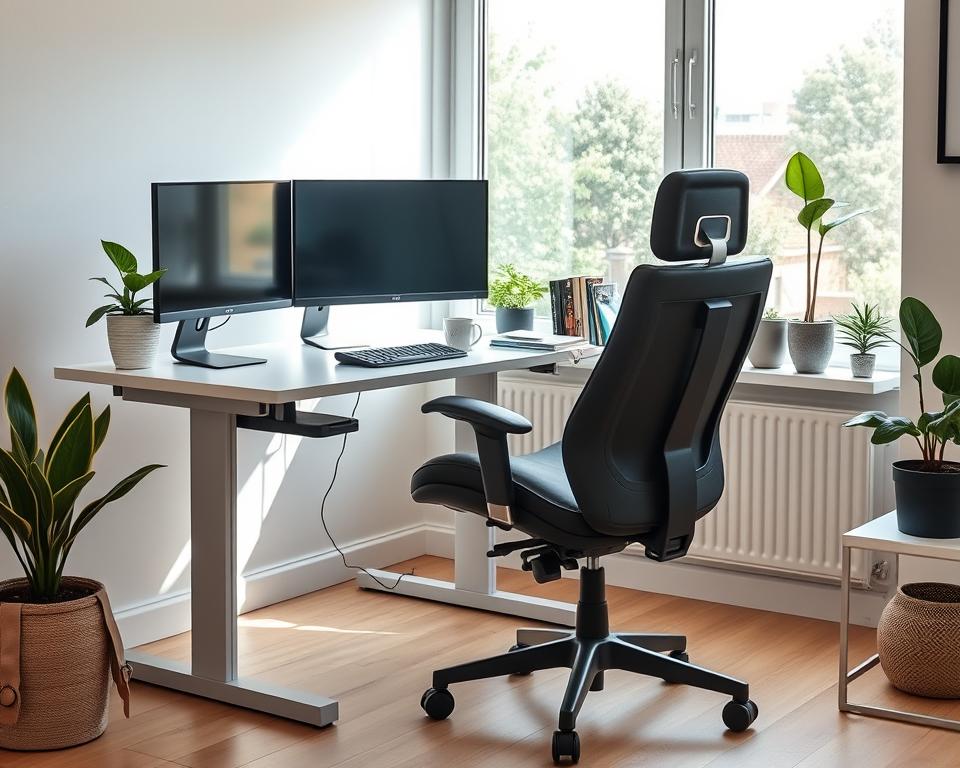
Monitor Setup and Screen Positioning
In an ergonomic home office, setting up your computer monitor(s) right is key. It helps keep your workspace comfy and productive. By following a few easy tips, you can cut down on eye strain and neck pain from too much screen time.
Optimal Viewing Distance and Height
The best distance for your monitor is 20 to 26 inches from your eyes. Make sure the top of the screen is at or just below eye level. This lets you look down slightly without straining your neck.
Multiple Monitor Configuration Tips
- For multiple monitors, place them side-by-side at the same height and distance. This creates a smooth visual experience.
- Make sure the bezels (the screen borders) are thin. This reduces the gap between screens.
- Set up monitors in a curved or arc shape. This cuts down on neck rotation and boosts ergonomics.
Screen Glare Prevention Strategies
Reducing screen glare is key for eye comfort and less strain. Keep your monitor away from bright lights. Use an anti-glare filter or screen hood if needed. Adjust the monitor’s brightness and contrast to match your work space.
“Proper monitor setup can significantly improve your overall ergonomic comfort and productivity in the home office.”
By focusing on your monitor’s ergonomics, you can make your home office more comfy and efficient. Simple changes can greatly improve your well-being and work performance.
Keyboard and Mouse Ergonomics
Setting up an ergonomic home office is more than just the chair and desk. It’s also about how you use your keyboard and mouse. This helps prevent injuries from repetitive strain.
First, make sure your keyboard is at the right height. Your wrists should be straight and neutral. A keyboard tray or adjustable desk can help get it just right. Keep your elbows close and avoid stretching your arms too far.
For your mouse, it’s all about the placement. Keep it near your keyboard to cut down on arm movement. Look for an ergonomic mouse that fits your hand well and reduces wrist strain.
- Invest in an adjustable keyboard tray to maintain proper wrist alignment
- Choose an ergonomic mouse that fits your hand comfortably
- Keep your mouse close to your keyboard to minimize arm movement
- Take regular breaks to stretch and avoid prolonged static postures
“Proper keyboard and mouse ergonomics can make a significant difference in your overall comfort and productivity throughout the workday.”
By following these ergonomic home office setup tips, you can greatly improve home office ergonomics. This reduces the chance of musculoskeletal disorders. Taking care of your body at work is key for your health and happiness.
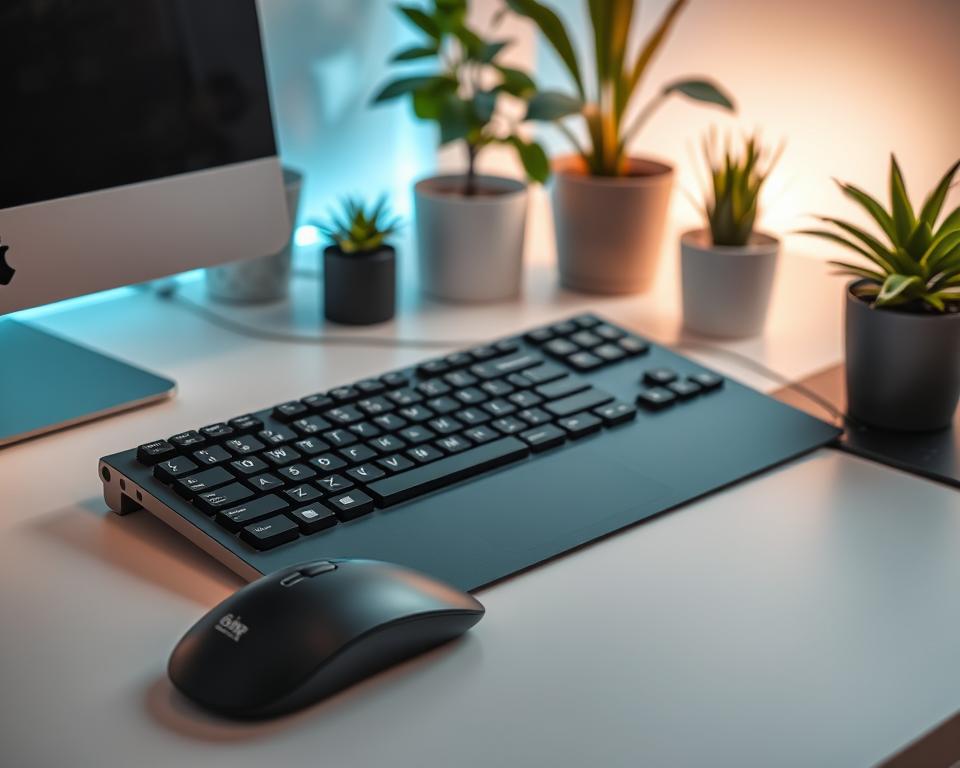
Workspace Organization and Storage Solutions
Having an organized workspace is key for a good home office. It makes your area look better and helps you work better. We’ll look at storage, cable management, and document systems to keep your space tidy.
Essential Storage Accessories
Choosing the right storage can really help. Use vertical space with shelves or cabinets for things you don’t use often. Desk drawers and organizers keep small items in order. File cabinets and storage boxes are great for documents and records.
Cable Management Techniques
Cords and cables can be a mess and a hazard. Use cable organizers, cable trays, or cable sleeves to keep them hidden. Cord routing and zip ties also help keep things neat.
Document Organization Systems
Keeping documents organized is important for a stress-free office. Use digital filing systems for easy access to files. Document holders and binders help with physical papers. Don’t forget to purge and shred what you don’t need.
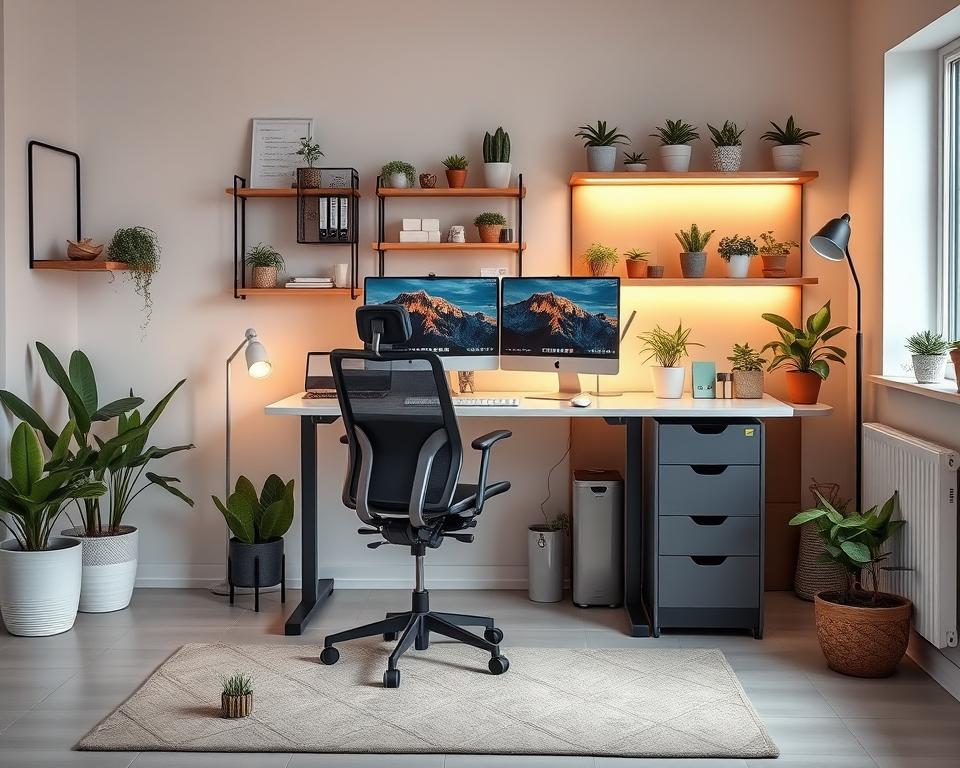
“An organized workspace not only looks visually appealing but also supports productivity and well-being.”
By using these tips, you can make your home office better. A tidy workspace boosts your productivity and happiness. It’s all about creating a space that works for you.
Lighting and Environmental Considerations
Setting up an ergonomic home office is more than just the desk. Lighting and the environment are key to comfort and productivity. Let’s look at how to make these elements work for an ergonomic home office setup.
Maximize Natural Lighting
Place your desk near a window for natural light. Natural light boosts mood, energy, and well-being. Positioning your desk to face the window also reduces eye strain and glare.
Optimize Artificial Lighting
Use ergonomic lighting solutions when natural light is not enough. Choose adjustable task lights for direct illumination without harsh shadows or reflections. Also, install dimmable overhead lights for a cozy, well-lit space.
Maintain Comfortable Temperature
The perfect temperature for an ergonomic home office is 68-72°F (20-22°C). Avoid extreme temperatures to stay focused and productive. Use a programmable thermostat or a portable heater/air conditioner to keep your space comfortable.
Ensure Proper Ventilation
- Open windows or use a fan for better air circulation.
- Get an air purifier to remove allergens and pollutants.
- Use a dehumidifier or humidifier to keep humidity levels right.
“Creating an ergonomic home office environment is essential for long-term health and productivity. By optimizing lighting, temperature, and air quality, you can ensure your workspace supports your well-being.”
By paying attention to these environmental factors, you can improve home office ergonomics. This will help you create a space that’s both comfortable and productive, supporting your overall health.

Ergonomic Accessories and Support Tools
Setting up an ergonomic home office is more than just the basics. The right accessories and tools can make your workspace more comfortable and productive. We’ll look at various ergonomic accessories to improve your home office ergonomics.
Wrist Rests and Palm Supports
Long hours of typing and mouse use can hurt your wrists and hands. Wrist rests and palm supports keep your wrists straight and reduce strain. Choose soft, comfy materials that support your hands and wrists well.
Footrests and Anti-Fatigue Mats
Good foot support is key for posture and avoiding leg fatigue. Ergonomic footrests help keep your feet up, improving blood flow and leg comfort. Anti-fatigue mats offer a soft surface for standing, easing back, leg, and foot strain.
Document Holders and Phone Stands
For tasks involving documents or phone use, ergonomic accessories are a must. Document holders keep papers close to your monitor, saving your neck and head. Phone stands help keep your wrists straight and avoid ear-to-shoulder phone holding.
Adding these ergonomic workspace ideas to your home office can significantly improve home office ergonomics. This boosts your comfort and productivity all day long.
“Ergonomic accessories are the unsung heroes of a comfortable and productive workspace. They may seem like small details, but their impact on your well-being can be significant.”
Creating an ergonomic home office setup is key for your health, comfort, and productivity. By learning about workplace ergonomics and using the right strategies, you can make your workspace better. This makes your work area supportive and efficient.
Getting the right ergonomic gear, like a good chair, adjustable desk, and monitors, is important. It helps you stay comfortable and avoid health problems. This way, you can work better and for longer without getting tired or hurt.
Keeping your home office ergonomic is a continuous task. You should check your setup often, make changes when needed, and look for more ergonomic tools. With some effort, you can make a workspace that’s good for your body and mind. It will also help you succeed in your work.

30 Tips for Ergonomic Home Office Setup
Creating an ergonomic home office is essential for maintaining comfort and productivity. Here are 30 tips to help you set up an ergonomic workspace:
- Choose an Ergonomic Chair: Select a chair that supports the natural curve of your spine, with adjustable height and armrests to maintain proper posture. Mayo Clinic
- Adjust Desk Height: Ensure your desk allows your elbows to be at a 90-degree angle when typing, keeping your wrists straight and relaxed. Mayo Clinic
- Position Monitor at Eye Level: Place your monitor directly in front of you, about an arm’s length away, with the top of the screen at or slightly below eye level to prevent neck strain. Mayo Clinic
- Use a Separate Keyboard and Mouse: If using a laptop, connect an external keyboard and mouse to maintain a neutral wrist position and reduce strain. PCMag
- Maintain Neutral Wrist Position: Keep your wrists straight and your hands at or slightly below elbow level while typing to prevent discomfort. Mayo Clinic
- Ensure Proper Lighting: Utilize natural light to reduce eye strain, and position your workspace to the side of windows to minimize glare. WebMD
- Use Anti-Glare Screen Filters: Install anti-glare filters on your monitor to reduce eye strain from screen reflections. WebMD
- Take Regular Breaks: Stand up and move around every 20 to 30 minutes to alleviate muscle fatigue and improve circulation. WebMD
- Incorporate Standing Periods: Use a standing desk or a desk converter to alternate between sitting and standing throughout the day, promoting movement and reducing discomfort. PCMag
- Position Frequently Used Items Within Reach: Keep essential items like your phone, stapler, or documents close to minimize excessive reaching and maintain a comfortable posture. Mayo Clinic
- Use a Headset for Phone Calls: If you frequently talk on the phone while typing or writing, use a headset to avoid cradling the phone between your head and neck, which can cause strain. Mayo Clinic
- Keep Feet Flat on the Floor: Adjust your chair height so that your feet rest flat on the floor, or use a footrest to support your feet comfortably. Mayo Clinic
- Maintain a 90-Degree Angle at Knees and Hips: Ensure your knees are at a 90-degree angle with your thighs parallel to the floor to promote proper circulation and posture. Mayo Clinic
- Use Document Holders: Place documents on a holder next to your monitor to avoid repetitive neck movements when referencing materials. Mayo Clinic
- Adjust Screen Brightness and Contrast: Set your monitor’s brightness and contrast to comfortable levels to reduce eye strain. Mayo Clinic
- Position Monitor to Avoid Glare: Place your monitor perpendicular to windows or use blinds to control natural light and minimize screen glare. Mayo Clinic
- Use a Stable Work Surface: Ensure your desk or table is sturdy and spacious enough to accommodate your computer and other work materials comfortably. Mayo Clinic
- Keep Cables Organized: Manage cables to prevent tripping hazards and maintain a tidy workspace, which can reduce stress and improve focus. Mayo Clinic
- Use a Footrest if Necessary: If your feet don’t reach the floor comfortably, use a footrest to support your feet and maintain proper posture. Mayo Clinic
- Maintain a Comfortable Room Temperature: Keep your workspace at a comfortable temperature to prevent discomfort and maintain focus. Mayo Clinic
- Use Ergonomic Accessories: Consider using ergonomic keyboards, mice, and wrist rests to support natural hand positions and reduce strain. Mayo Clinic
- Keep Your Workspace Organized: Maintain a clutter-free desk to enhance productivity and reduce stress. Mayo Clinic
- Incorporate Plants: Adding plants to your workspace can improve air quality and create a more pleasant environment. Mayo Clinic
- Use a Desk Lamp: Provide adequate lighting for reading and writing tasks to reduce eye strain. Mayo Clinic
- Adjust Screen Position for Bifocal Users: If you wear bifocals, lower the monitor an additional 1 to 2 inches for more comfortable viewing. Mayo Clinic
- Use a Laptop Stand: If using a laptop, place it on a stand to elevate the screen to eye level and use an external keyboard and mouse to maintain ergonomic posture. Mayo Clinic
- Ensure Adequate Desk Space: Keep your desk free of unnecessary items to provide ample space for your work materials and equipment. Mayo Clinic
- Use a Stable Chair Base: Ensure your chair has a stable base with five points of contact to prevent tipping and provide proper support. Mayo Clinic
- Adjust Armrests: Set your chair’s armrests so your shoulders are relaxed and your elbows are close to your body, supporting your forearms while typing.


